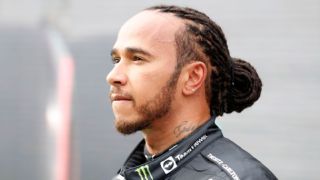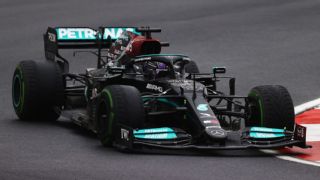|
Overruling Lewis Hamilton on tyre strategy is always a bold call. With nearly 15 years of experience in F1 and seven world championships to show for it, Hamilton's racing intuition is arguably one of the most valuable weapons Mercedes has in its strategic armoury, but at Sunday's Turkish Grand Prix it was ignored. Such decisions are even harder to make when they drop a car from a podium position to fifth place, as happened with Hamilton when he pitted on Lap 50 of the Turkish Grand Prix, but in this case it was the right decision. What happened?Starting from 11th on the grid due to an engine penalty, Hamilton had a tough job ahead of him Sunday. The wet track appeared to offer an opportunity for the seven-time world champion, who won in Turkey from sixth last year, to come through the field, but it never really came together. This year's Turkish Grand Prix was unlike any wet Formula One race in recent memory. Even though the rain was reduced to a drizzle and stopped altogether in the second half of the race, the track never truly dried out. Given that a single intermediate tyre is capable of evacuating 30 litres of water per second from the track surface when it is running at 300km/h, there was an expectation that 20 cars with four tyres each would dry the track, but that never happened. Ahead of the race, some members of the Mercedes team were predicting a dry line on track by lap 10 of the race, while Hamilton himself expected it to emerge by lap 30. Yet after 58 laps of racing, the track was still not ready for slick tyres, making strategy calls trickier than normal. With the benefit of hindsight, the fastest way to the chequered flag was to stop for a second set of intermediate tyres at some point between lap 35 and lap 42. That's what Valtteri Bottas did and, in the same Mercedes car as Hamilton, won the race at a canter 14 seconds ahead of Verstappen. So why wasn't Hamilton able to take advantage of the Mercedes' pace in the same way?  Hamilton finished fifth, which is the same position he was in when drivers started to make their pit stops. Red Bull's Sergio Perez had held him off in an impressive display of defensive driving at the end of lap 35 and then pitted a two laps later, conceding position to Hamilton but getting a new set of intermediate tyres in exchange. Hamilton ignored a call to pit four laps later on lap 41, arguing against his team belief that a second set of intermediates was the quickest and safest way to the flag. Judging by other radio communications around that time of the race, Hamilton was still harbouring hope that the track would dry enough to switch to slicks, which, if he could wait long enough on his existing tyres, would eliminate the need to pit twice. Had that happened, he would have gained a position on Perez and, had the timing of the switch to slicks been perfect compared to Bottas, Max Verstappen and Charles Leclerc, would have had a shot at victory. There were other factors clouding the logic of switching to a second set of intermediates, too. As more of a dry line emerged, every driver that switched to a new set of intermediates struggled for the opening few laps of their new stint. The super soft compound on the intermediate tyres was "graining" on the surface, meaning the top layer of rubber was rolling up into little balls rather than biting into the track. For several laps the tyres would struggle for performance until the problem cleared up, the rubber on the surface of the tyre started to smoothen out and then offered up its true performance. On lap 42, Mercedes again had a conversation over pitting, with race engineer Peter Bonnington saying it would offer more "thinking time". By that point, Perez and Pierre Gasly, who Hamilton had passed for fifth place on lap 14 of the race, were both several laps into their second set of intermediates but neither was finding massive gains over Hamilton's pace. By virtue of not pitting, Hamilton had gained fourth place from Perez, a comfortable gap of 15 seconds and the flexibility of making the switch to slicks if necessary. However, he had traded the ability to switch to intermediates and leapfrog Perez in the pit stops, as doing so now would concede track position back to Perez with the graining phase meaning he was unlikely to catch up. The Ferrari of Leclerc was attempting to pull off a similar strategy to snatch victory from Bottas, but two mistakes at Turn 12 showed how difficult it would be. The Ferrari driver was clearly struggling with his tyres already and soon conceded position to Bottas at Turn 1. For Mercedes, which was naturally delighted to see Bottas back in the lead, it was a warning sign of what could happen to Hamilton. During its "thinking time" the Mercedes pit wall weighed up the worse-case scenario. Some of the tyres coming off rival cars were worn down to the carcass and Pirelli had started telling its technicians to advise teams not to run to the end of the race. "When we saw Charles drop off in the Ferrari, we could see the loss in performance comes quite quickly and we started to see a bit of a drop with Lewis," Mercedes chief trackside engineer Andrew Shovlin said after the race. "Suddenly we saw on the [race] planners that the positions we would lose by doing the pit stop [for intermediates] we would lose anyway on track, to Perez and Charles and even a risk of losing more if you really dropped off the curve. So it was really a case of cutting our losses and not getting too greedy." By lap 46 Hamilton was losing well over 0.5s per lap to the cars that had already pitted, and on lap 47 alone lost 1.4s to Gasly in sixth. At this stage, he still held a 25 second advantage over the AlphaTauri, but that gap was only going to narrow over the next few laps and fairly soon it would mean Hamilton would no longer be able to pit for fresh intermediates and remain ahead of Gasly. It was around this time that Mercedes also came to the conclusion that Hamilton's current set of intermediates would not make the end of the race. Monitoring temperatures they could see that his performance was spiralling downwards and looking at the tyres visually they could start to see some of the carcass of the tyre emerging on the front left tyre. The white chords from the carcass become visible when there is literally no rubber left in the tread and it was becoming clear that Hamilton was running the risk of not just a loss of performance but a tyre failure.  One driver did make the end of the race without pitting and earned a point for tenth place as his reward: Alpine's Esteban Ocon. Talking to French TV after the race, Hamilton learned that Ocon had gone to the end of the race on a single set of tyres and reacted by saying, "if Ocon did it, then I could do it". But Ocon making the chequered flag on one set of tyres was only part of the story. On lap 48, when Mercedes decided it would definitely pit, Ocon was running in ninth, five seconds ahead of Lance Stroll in tenth place (who had eight-lap old intermediates on his car) and 21.9s head of Antonio Giovinazzi in 12th (who had seven-lap old intermediates). By the end of the race, Ocon had dropped to 21 seconds behind Stroll (a net loss of 26 seconds) and was just 0.7s ahead of Giovinazzi in the relatively uncompetitive Alfa Romeo. When Ocon pulled up in parc ferme after the race, his front right tyre was worn right through to the carcass. Both he and Pirelli admitted he was lucky to finish the race. Using the Ocon example to apply a similar drop in tyre performance to Hamilton's car, and he would have not only finished behind Perez and Leclerc, but most likely would have lost out to Gasly and Lando Norris as well - all the while, running the risk of a complete failure. In that context, Mercedes' decision to pit Hamilton on lap 50, dropping him from third to fifth, was absolutely the right one. Ideally the team would have pitted Hamilton earlier than Perez to try and gain an advantage over the Red Bull and hoover up the position lost by Leclerc when he stayed out too long, but that is a decision that Hamilton would almost certainly have rejected based on his radio messages around lap 42. Hamilton: I'm a risk takerBut even after his debrief, having seen all of the information above and more, Hamilton still seemed to think he could have made a no-stop strategy work. "Again, if I'd stayed out you don't know if I would have held position but I'm a risk taker so I would have wanted to take that risk," he said. "But you know, we started 11th today, got a new engine, so we got points. "It just feels that in that moment I only have a certain amount of information and the team have other information, they see everyone else. For me it's hard to want to give something up when you don't fully know the whole picture. "That's why you have to rely on your team and accept the choices they make and hope it's the right one. I always say we win and lose as a team. "I listened to the team today. Could we have stayed out? Who knows, if you look at a couple of others that did they dropped off massively and lost positions, so it was a risk either way." From the team's side, Shovlin is confident the data backs up the pit wall's decision, he's happy to have a driver that is always demanding more. "Lewis is always looking at what's ahead of him and what is the most he can get," he said. "He's deeply invested in this championship, and we wouldn't really expect anything other than frustration at a P5 when at one point we thought we might be able to hang on for third. "But we will go through that with him, we've had a debrief with him now and I think he understands the reasons. It's just the kind of frustration from him that at times in that race he thought he was going to be on the podium and that didn't come true. I think there is a bit of disappointment in that. "But if we look at how we operated, it was sensible and in a championship battle there is a point when you've got to stop taking risks and cut your losses. And although those decisions are difficult to do, you have got to be strong and you have got to take them."
|
